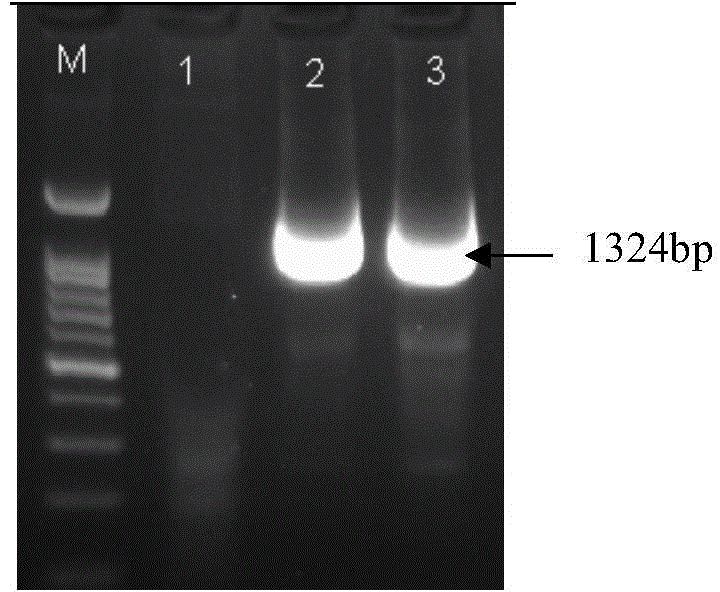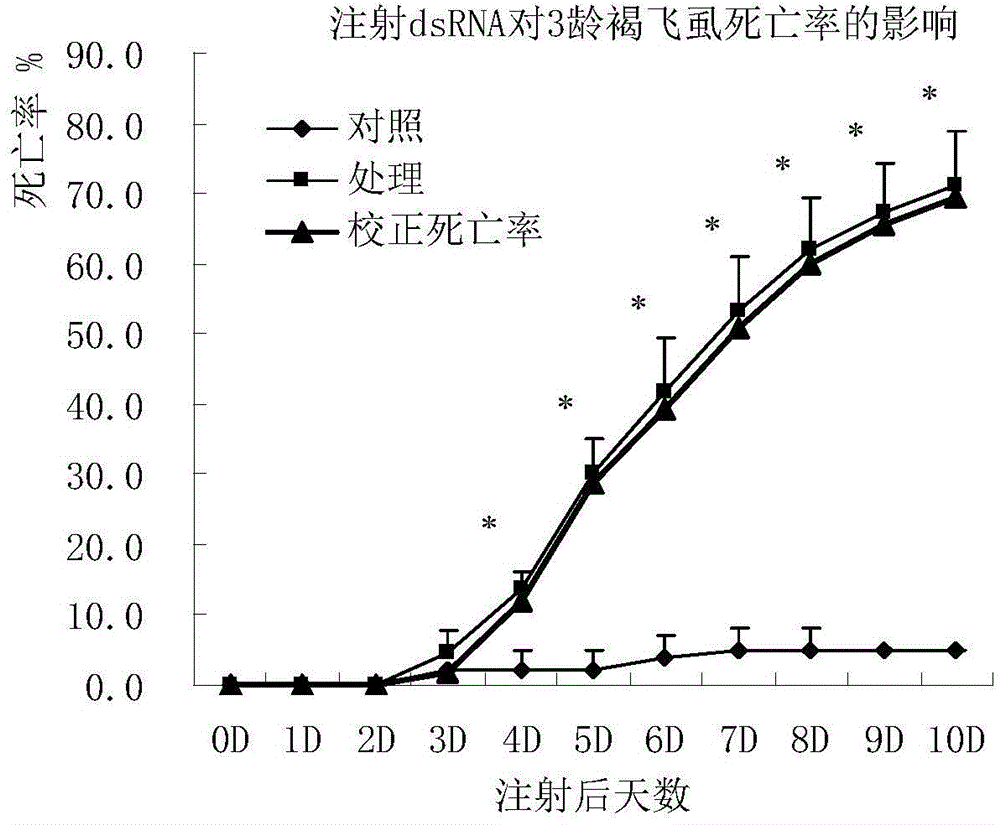Brown planthopper protein translation elongation factor NlEF1gamma, and encoded protein and application thereof
A technology for translation elongation factor and elongation factor, which is applied to the translation elongation factor NlEF1γ of brown lice protein, encoded protein and its application field, and can solve the problems of large difference and low survival rate.
- Summary
- Abstract
- Description
- Claims
- Application Information
AI Technical Summary
Problems solved by technology
Method used
Image
Examples
Embodiment 1
[0040] Cloning of embodiment 1, NlEF1γ gene, synthesis of dsNlEF1γ
[0041] 1) Cloning of NlEF1γ gene
[0042] Use Qiagen's RNeasy Mini kit (74106) to extract RNA from 5-10 whole brown planthoppers, and use Toyobo's ReverTra AceqPCR RT Kit to synthesize cDNA sequences. 10 μL synthesis system contains 1ng RNA, 2.0 μL 5xRT buffer, and 0.5 μL primer mix , 0.5 μL RT enzyme mix. Incubate at 37°C for 45 minutes, inactivate reverse transcriptase at 98°C for 5 minutes, and dilute the cDNA 10 times as a template for cDNA amplification of the target gene.
[0043] The sequence fragment of the NLEB4403 gene in the NLEBPH EST database was matched with the transcriptome database in our laboratory to obtain the sequence fragment of the NLEBPH NlEF1γ gene, and the upstream primer NlEF1γ-F1324 was designed according to the NCBI primer blast: ATTTCGATCGTGCTCTCTCTCT (SEQ ID NO.3), and the downstream primer NlEF1γ - R1324: GCCTTTCTCAACCCGTTCCC (SEQ ID NO. 4).
[0044] PCR amplification system...
Embodiment 2
[0058] Example 2, the injection experiment of dsNlEF1γ to the 3rd age brown planthopper
[0059] Make agarose gel grooves for fixing N. lugens: prepare agarose gel with a mass concentration of 2.0-2.5%, pour the melted agarose gel into a petri dish with a diameter of 9 cm, the height of the agarose gel is slightly higher than the petri dish, Place 4-5 capillaries with a diameter of 0.5-0.8mm above the Petri dish. After the agarose gel is cooled, remove the capillary to obtain the groove of the agarose gel that can fix the brown planthopper; select 3-4 instar brown planthopper nymphs and blow them into the glass test tube, and use CO 2 After 2 minutes of anesthesia, the brown planthopper was poured into a petri dish filled with agarose gel in advance, and the brown planthopper was neatly placed in the groove of the agarose gel with a soft brush.
[0060] Using an eppendorf microinjector (Model TransferMan NK2, Shanghai Eppendorf Company), each brown planthopper was injected wi...
Embodiment 3
[0061] Example 3: Feeding experiment of dsNlEF1γ to 2nd instar brown planthopper
[0062] Place the glass tube (15cm×2.5cm) with both ends open upright on the ultra-clean workbench, pull the upper end evenly to both sides with a square sealing film, seal the upper open end, and use a pipette to absorb 70.0 μL of artificial feed Drop in the center of the parafilm, the control group only added artificial feed (see Table 1 for the formula), the treatment group added dsRNA (final concentration 50ng / μL) to the artificial feed, used a new parafilm, and stretched the sticker evenly with the sticker facing down. The feed and dsRNA were sealed between two layers of parafilm above the feed-added parafilm.
[0063] Take 30 2nd-instar brown planthoppers with an insect sucker and gently blow them into the glass tube from the open end of the glass tube, and seal the open end with sterilized gauze; each treatment is repeated 10 times; the glass tube with the added feed and blown into the bro...
PUM
 Login to View More
Login to View More Abstract
Description
Claims
Application Information
 Login to View More
Login to View More - R&D
- Intellectual Property
- Life Sciences
- Materials
- Tech Scout
- Unparalleled Data Quality
- Higher Quality Content
- 60% Fewer Hallucinations
Browse by: Latest US Patents, China's latest patents, Technical Efficacy Thesaurus, Application Domain, Technology Topic, Popular Technical Reports.
© 2025 PatSnap. All rights reserved.Legal|Privacy policy|Modern Slavery Act Transparency Statement|Sitemap|About US| Contact US: help@patsnap.com



